The ultimate sme business growth blueprint
MASTER MARKETING YOUR BUSINESS USING THIS EASY TO FOLLOW AND IMPLEMENT GUIDE
(click any Chapter below to jump directly to that section)
Chapter 1: Why This Blueprint was Created and Who Wrote it.
Chapter 2: What kind of Marketing Should You Spend Money On (And In What Order).
Chapter 3: The Bird’s View of Your Money-Making Marketing Stack.
Chapter 4: Your Website and What It Should Do.
Chapter 5: Your Facebook Page and Why It Is Extremely Important
Chapter 6: Follow-up Systems. Using a “Newsletter” to Get More Business from Existing Customers
Chapter 7: How to Drive New Business with Facebook Ads and/or Google AdWords.
Chapter 8: What is a Messenger Bot (And Why You Need One).
Chapter 9: How to Show up in Google Ahead of Your Competitors (SEO).
Chapter 10: Getting Your Clients to Come Back Again and Spend More Money with You.
Chapter 11: Orchestrate Referrals from Existing Customers and Partnerships.
Chapter 12: How to Get Someone to Do Everything for Your Business
CHAPTER 1: WHY THIS BLUEPRINT WAS CREATED AND WHO WROTE IT

Before we dive in, I want to say how excited that I am that you’re reading this blueprint. Creating this was a labour of love and I hope it helps you to grow your business in the same way I’ve been able to help so many of my clients.
My name is Uldis Zalcmanis. Since no-one in Malaysia and many other countries can properly pronounce my last name, I’m often referred as Uldis Biz, haha. I’m originally from Europe, (since 2010 residing in Malaysia) and I got into Direct Response Marketing and, eventually, its more technical brother – Digital Marketing because I needed a way to grow my businesses when traditional means of promotion didn’t work to the extent I expected.
Years ago, it became clear to me that what they typically taught in Universities (Branding, Image/Institutional advertising) isn’t working for me (neither it was working for most of my clients). I didn’t have deep pockets to saturate the marketplace and I didn’t have the patience.
I had to get clients right now!
It was clear that what I needed was the predictable, systematic and profitable way to generate leads and convert them into paying customers.
And then, I needed a way to make the customers come back and buy more stuff from me and my clients.
I have made it my mission to become an expert in helping brick and mortar businesses grow using Direct Response Marketing and Digital Marketing. I’ve spent tens of thousands of dollars and countless hours learning about and testing just about every digital marketing technique under the sun.
All that research and testing led me to what works, what doesn’t work, and what order you should do everything in to get the biggest bang for your buck.
This “Blueprint” will help you understand the techniques that you should be implementing in your business and how to be more informed when hiring someone to help you implement them.
This guide isn’t meant to be consumed in one sitting. Bookmark this guide, read it in chunks, and come back anytime to keep learning more.
Or, alternatively, you can get it in pdf version so you can take it offline and read when the opportunity presents itself.
Let’s get started with a bird’s view of what you should be doing to market your business online (and offline) and in what order.
CHAPTER 2: WHAT KIND OF MARKETING SHOULD YOU SPEND MONEY ON (AND IN WHAT ORDER)

There are so many options out there when it comes to marketing your business. With all those choices, it’s hard to know what the most effective ways to spend your business’ marketing dollars are.
After years of working with businesses and helping them with their marketing efforts both online and offline, I’ve compiled a ton of data that has lead me to know exactly what works and what doesn’t. Putting that data into practice has led our clients to be extremely successful with their marketing.
Businesses that are successful marketing themselves (and don’t overspend) have mastered something that we call the “Marketing Stack”.
This “Marketing Stack” is a term that we came up with to describe the order that you should implement certain marketing tactics so that you squeeze every dollar of value out of everything that you’re doing both online and offline.
When you hear a business owner say that they failed using a certain type of marketing online, it is usually because they used a technique that didn’t have a good foundation.
For example, it doesn’t make a lot of sense to run a Facebook Ad campaign to generate leads for a business if the business has a website and/or Facebook Page that doesn’t look great. This campaign typically fails because prospective customers like to do additional research when they see an offer on Facebook. If they see an offer and then go look at a webpage or Facebook Page that looks like your nephew built it in 1995, that doesn’t make them want to actually claim the offer they saw on Facebook.
I’ve seen a ton of business owners who have run a special offer with Facebook Ads (on their own) that ultimately failed at first due to them not having their “digital house in order”. In short, their brand looked terrible when people did just a little extra checking on them (because their website and Facebook page weren’t optimized).
We ended up running a nearly identical Facebook campaign when they signed up with us, but with one big difference.
The big difference was that we laid the groundwork for their campaign before we ran it. We made sure that their website and the Facebook page looked great before we ran the campaign. When potential customers saw their ad, they got a good impression of the business on their other properties and followed through with claiming the offer because of it.
With that said, in what order should you set up your Marketing Activities?
Come along with me and I’ll show you EXACTLY what to do and in what sequence.
CHAPTER 3: THE BIRD’S VIEW OF YOUR MONEY-MAKING MARKETING STACK

Stage 1. The Foundation. Making Sure You Look Good When They Look for You
These strategies must be put in place before you move on to stage 2.
It’s important to understand what happens when a prospective customer hears about your business from a friend, a radio ad, the newspaper, or from any other place you might come up.
Whether it be from a referral or any other marketing channel, the typical person will do a little pre-research on your business before they ever pick up the phone or walk through your front door. Before anyone decides to do business they typically do two things.
The two ways prospective clients research you:
1) They search for you on Google.
First, they’re going to head over to Google and they are going to check out your website. You need to make sure that your website is doing some key things and that it looks a certain way. We cover all of that here.
2) They search for you on Facebook
Second (and sometimes first) people are going to type in the name of your business on Facebook and see what’s happening there. People go to your website to get basic information, they search for you on Facebook because they want to get a peak at “what is actually happening on the inside”. I cover more on why your Facebook page has to look great and must be active right here.
So, here you have the fundamental blocks to build upon all the rest:
- Website. Think of your website as the digital version of the front of your office. It needs to look inviting and give people the basic information, they are looking for. But that’s not it. If you truly want to squeeze maximum value out of the all the eyeballs, you need to make sure your analytics, targeting pixels, and… most importantly, lead magnets (explained here) are in place.
- Facebook Page. An overwhelming amount of people search for businesses on Facebook. Your page has to look active or people will assume that you aren’t busy or worth trying out. At the very least you need to have a regular posting schedule. More about it here.
Stage 2. The Basic Growth Strategies. Getting More Business through the Door.
The first stage is first, remember? If you’re done with it, here’s what to do next.
Once you have a great website and have your Facebook page posting content daily, you officially have a foundation laid for your business to start reaching out for more business through your digital assets. If you didn’t have the foundation laid, your lead generating activities (Facebook Ads and Email Newsletters) could fall flat when people did a little research on you, after seeing your ad or emails.
With your foundation laid, you want to focus your attention on two “business driving” activities. One of the activities is designed to get more of your existing customers through the door (Email newsletters). The other is designed to get new prospects through the door (Paid Advertising).
Here they are, the two main ways to drive more business through the door:
- Follow-up Systems. The easiest way to make more money in your business is to communicate more with the people who already love your business. The cheapest and the simplest way to do so is either by having a CRM (Customer Relationship Management) system with a follow-up workflow or just send out a monthly or weekly e-mail newsletter. As new technologies (Messengers, Push Notifications) are advancing and the way we interact with each other is changing, email can become less relevant but at the end of the day what matters is – you have a system in place to systematically stay on top of the head with your prospects and your existing clients. You can’t even imagine how much money you are leaving on the table if you are skipping this step. The secret is to make sure that your email newsletter is something that contains a value in itself. I cover more on how to create an email that drives more income into your business right here.
- Paid Advertising. At the moment of writing the easiest way to get new customers is to put a great offer in front of them either on Facebook or using Google AdWords. There are other platforms (Instagram, Youtube, Direct Mail, Print Media etc.) that fit certain business models and offers but, for most offline businesses Facebook and AdWords are the places to start. If the idea of spending money on ads make you cringe – I get it. It’s normal. Don’t fight it. But, let me reassure you – if you know your numbers and approach your advertising efforts scientifically (using scientific methods of Direct Response Advertising; measure, track, analyze and improve based on metrics not guesswork), you will be surprised to find out how financially stable, predictable and lucrative your business can become. Although Facebook Ads is one of the easiest ways to reach the kinds of people that would be a perfect new customer, most businesses fail. Why? Because they have no idea how to set up the kind of ‘sales funnel’ that works well with this medium. I cover exactly how we successfully use Facebook ads with our clients right here.
Stage 3. The Domination Strategies (Advanced). How to Become Number 1 in Your Market
Once you have all the Foundation components (Website and Active Facebook Page) and are effectively driving more income-generating business with things like Email Newsletters and Facebook Ads/Google AdWords Ads, it’s time to focus on the things that allow you to dominate your local marketing.
These techniques are a little more technical and take a little more time to implement properly, but allow you to be years ahead of your competition. We focus on a few main “advanced strategies” to help our clients dominate their markets.
Before I jump into them, here’s a thing very few business owners are aware of (and even fewer are actually implementing) – in the game of competition the one who can spend the most to acquire a customer wins (and, no – it is not the one with the best product!). How can you spend more? I’m glad you asked.
By increasing your average CLV (Customer Lifetime Value). In general, there are only 7 areas of focus that can increase the CLV and give a significant boost to your profits:
- Number of leads
- Conversion rate
- Number of transactions
- Transaction value
- Profit margin
- Number of referrals
- Customer Buying Lifetime
To cover all possible ways, I’d have to dig deep into your specific business but here’s what works for literally every business:
- Facebook Messenger Bots are the best way to connect directly with a potential customer and blow them away not only with a great offer but with how cutting-edge your business is. Just imagine, what if you could have a salesperson out on Facebook 24 hours a day looking for people who need your services and reaching out to them with an offer that would get them to come into your business? Facebook Messenger Bots are the next best thing (and they don’t ever sleep). We have had amazing success with Facebook Messenger Bots. You can see an example of how we use them right here.
- SEO (Search Engine Optimization) (AKA: Being Loved by Google). Showing up first on Google when someone searches for a profitable keyword takes work and patience but is worth a fortune to your business. It is a long-term investment in your business, but it’s one that is important to make. I’ll show you exactly how we help our clients rank for those all-important “business generating keywords” right here.
- Loyalty Programs. Whether you are using old-school punch-cards and Excel sheets or sophisticated digital tools (like our Business Boostly™) to track your customer purchase amounts and frequency, doing it the right way will ensure your customers come back more often and spend more money with you. If you know that all your clients come back to you every single time and are not even peaking at competitors – feel free to skip this tactic. For the rest of us – you’ve got to do something about it. I’m showing you a few great angles of this right here.
- Referral Systems. If you have been in the business for more than 3 years, I bet you are generating part or even all of your business through the word-of-mouth. And it’s great. It truly is. The problem is that unless you have a systematized referral program in place, you are relying on random acts of kindness from your peers and clients while you should be having a predictable flow of new customers instead. Here’s a great example of how you too can predictably and systematically orchestrate referrals.
CHAPTER 4. YOUR WEBSITE AND WHAT IT SHOULD DO

The most important thing you can do when marketing your business on the Internet is creating a “home base” where people can learn about you and what you do. A great website should be the centrepiece of your digital (and not only digital) marketing and all of your efforts should lead back to this site.
Just like you update the decorations and front-facing aspects of your physical location as the years pass, you should also make sure that your website is updated and gives a true reflection of what your business is all about.
One of the big mistakes that Brick and Mortar business owners make is thinking that Social Media sites like Facebook have replaced the need for a business website. While it’s true that your Facebook Page is extremely important, your website is still the first place people look for when they want to get more info on your business from the internet.
You have to make sure that your website, at the bare minimum, has the core components that it needs to give people what they came for. At the same time, you have to make sure your website makes a great impression every time someone visits it.
Let’s talk about the 11 things every brick-and-mortar website must have.
The 11 things Your Business Website must have:
#1: A Professional and Current Appearance.
It’s not enough to just have a website these days. You have to have one that looks good and is easy to navigate.
There is nothing worse than having a website that looks like it was designed in 1995 and hasn’t been touched since. Having an outdated website telegraphs that you and your staff don’t pay attention to details and don’t care about staying current. Whether it’s fair or not, this can shift the way they think that you operate inside of your business as well.
Mobile device friendly website is a MUST! Majority of the site visitors will come from the mobile devices. If your site is not mobile device friendly – they will most likely abandon it without even having a look.
It’s important that you have a professional design your site to be easy to navigate and to look current. It’s also extremely important that you have someone who makes sure that your site loads quickly and does weekly check-ins on your website’s health (hackers are always coming up with new ways to do damage so it’s key that you have a pro monitoring things for you. Most of the time you won’t even know your site has been hacked…)
#2: A Peak Inside Your Location/s.
Simply put, people want to know what the inside of your business looks like before they ever decide to step foot inside of it in real life. Giving them this window into your physical location goes a long way to helping them make the decision to do business with you.
#3: Pictures of You and Your Staff.
People want to know who they will be dealing with when they decide to do business with you. It’s important for them to see your face and the faces of the people they’ll be dealing with once they come in. Putting your staff’s pictures on your website is a critical component to converting casual website visitors into paying customers.
#4: A Contact Page with Your Hours and Address.
The number one reason that people will visit your website is to figure out what your hours are, how to contact your business, and how to get to your Physical Location.
#5: Menu of Services or Products.
Having a page that describes your main services or products is a huge part of converting people into customers. A little bit of detail on what someone gets when they spend their hard-earned money with you goes a long way.
#6: A Link to Your Facebook Page.
Today’s consumers typically don’t just look at your website when they are deciding whether or not to do business with you. Statistics show that consumers are overwhelmingly also using Facebook to look for your business.
Linking people to your Facebook page from your website instantly gives them a way to learn more about your business without them having to look for it themselves (we talk about why Facebook Pages are such an important piece of your marketing puzzle here).
#7: Content that Proves Your Expertise.
One of the most important parts of a great website (but most overlooked) is a piece of content that shows that you really know your craft. This content is usually educational in nature and may take the form of a blog post, email download, or digital book.
We create these for our clients (because they usually don’t have time to do it themselves) and this very page is an example of the kind of content that proves, in this case, my expertise in the field of growing businesses. This piece of content is the kind of thing that really helps people understand what we do and how we can help them.
#8: Onboarding Documents.
This one doesn’t apply to every business but is vitally important to those that it does. If you run a business that requires people to have an exam, take a test, or apply for credit, it’s important to share those documents on your website.
This helps your potential customer prepare before they ever walk through the door. It also helps your staff point potential customers to essential documents when they are on the phone with them.
A great example of this would be a Chiropractic clinic having their “new patient health history” forms on their website so that new customers could fill them out before their visit.
#9: An Always Visible Call to Action.
No matter what page of your website someone happens to be on, they need a link to immediately start the process of doing business with you.
This could be as simple as a link that says “call us now” (remember that a large percentage of people visiting your website will be viewing it on their mobile phones).
#10: Analytics and Tracking Cookies.
If you are not planning to go to the growth stage 2, consider this point optional. However, if you are serious about growing your business – it is absolutely mandatory! You can not imagine how many times I’ve seen companies running ads on Google or Facebook when their analytics aren’t properly set up. As a Direct Response marketer, I want to find out what works and what doesn’t as quick and as cheap as possible and react based on the statistical evidence. It is impossible to know for sure unless you track it. Another reason for having proper tracking in place is so you can keep following up with those who saw your offer but didn’t take it on. Most of the people for different reasons will not take you on your offer at the first time so you will have to have multiple ‘touch points’ with them. If it ever seems like after you visited a website, you suddenly are being ‘haunted’ by their ads everywhere, congratulations – you have become ‘a victim’ of re-targeting (aka re-marketing). It’s a smart marketing tactic and can be very lucrative if applied strategically.
#11: Lead Magnet and Lead Capture Mechanism.
Here’s the cold hard truth you may or may not know, 99% of your website’s visitors will most probably forget about you the very next moment and are very unlikely to return again. It’s a lot of waste!
Instead of letting them go empty-handed you will now offer them a Lead Magnet in exchange for their email address.
A Lead Magnet (aka gated content) is a valuable offer or incentive — usually a content download, demo, discount coupon or free trial — behind a landing page. You provide online users with this content in exchange for their contact information (email address at the very least). Lead magnets are one of the most powerful marketing assets that you can have because of their ability to generate business leads.
Once you get their e-mail address (in some cases it makes sense to ask for a phone number), you can follow-up (most or all of which can be automated), nurture the relationships, educate and, eventually, convert these leads into customers.
CHAPTER 5: YOUR FACEBOOK PAGE AND WHY IT IS EXTREMELY IMPORTANT (iNSTAGRAM IS oPTIONAL)

Over the last few years, Facebook has taken steps that have made it harder for businesses to get their Facebook page’s content to show up in the news feeds of people who like their page (in fact, less than 2% of your Facebook page’s followers actually see what you’re posting). This was done because there were so many business pages and personal pages competing for space and it only made sense to lend more space in a person’s newsfeed to their personal relationships.
Many business owners started to believe that because their pages started vanishing from the newsfeed that there was no longer any reason to put any effort into creating new content for their page.
While the reasons for having a Facebook page for your business and posting to it often have changed, it is actually more important than ever due to one key reason.
Why Facebook Pages are More Important Now than Ever.
The role of a Facebook Page has changed dramatically in the last few years. Today a Facebook page is extremely valuable to businesses because it is the second place (behind only your website) that people search for when they are looking to know more about you.
And more specifically, people go to your website to see your “professional image”. They come to your Business’ Facebook page to get a sense of your “business personality’.
Statistics show that people are overwhelmingly using Facebook as a “first-hand source” of information about a business when they hear about them from a friend or from a more traditional marketing source (radio, tv, print, etc).
With the above in mind, I’d like to show you what we do to help our clients stay ahead of their competition and to use their Facebook page to convert new business every single week.
The 5 things Your Facebook Page Must Have:
#1: A Professional Profile Picture with your Logo.
This Picture is going to be one of the key elements that people use to judge your business when they first land on your page or see something that you’ve promoted with a Facebook Ad (more on that soon). You need to make sure that it has your logo featured, looks professional, and isn’t overly complicated.
#2: A Professional Cover Picture.
Your page’s cover photo is a great place to showcase your staff, facility, or to give people a hint as to what your business is all about.
#3: An Autoresponse Message.
Your staff may not be able to answer every message that gets sent to your Facebook page right away. Because of that, we set up a quick auto-response message on all of our client’s page that will let people know that we will answer their message soon, but to call the business at a certain number if they need help immediately.
#4: A Completely Filled out Business Profile.
Remember, we are optimizing our page to help people find us when they use Facebook’s search box. This means that we need to pay special attention to how we fill out our business’ profile on Facebook. This is a great guide that will show you exactly what we do when we help a client with filling out their Business page profile.
#5: Fresh Content Posted 2x Daily.
One of the most important things that you must do with your Facebook page is to make sure that it appears current and that it educates people about what you do. To appear current on Facebook (and to appeal to Facebook’s algorithms, you should be posting content 1-2x a day on your page.
This is something that most of our clients don’t have time to do, so we take over all of the content creation and posting duties for them. This is critical because it shows people who search for our page that the business is on top of things and paying attention to details.
CHAPTER 6: FOLLOW-UP SYSTEMS. USING A “NEWSLETTER” TO GET MORE BUSINESS FROM EXISTING CUSTOMERS

One of the easiest ways to make more money in your business is to get your existing customers to come back more often and to buy more services/products from you.
The reason this is one of my favourite techniques is due to the ease at which it can be implemented for a client. Most businesses already have a list of existing clients and their email addresses. Most of these existing clients already love the business and the products that they sell. They just need a subtle reminder to come back in and visit.
This can be done with a simple email newsletter that is sent out once a month. This newsletter functions to cut through all the noise of your existing customer’s daily lives and remind them why they fell in love with you in the first place.
We write newsletters for our clients each and every month and the key is making sure that the email that you send out isn’t something that is just the latest promotion. It has to be something they look forward to reading because it feels personal and because it helps them.
With that said, there are 4 key components to every email newsletter that we write for our clients. These 4 things are the key to why the newsletters that we write end up driving so much extra business for our clients (without their customers feeling like they are being “sold to”).
How to Write a Great Newsletter for Your Business
#1: Open with something topical
The first part of your email newsletter should be something that makes it easy for your readers to relate to you. When we write newsletters for our clients, we typically open up with something that is seasonal or has to do with a holiday that everyone in the area is celebrating.
This establishes a bond early in the newsletter and opens the door for us to talk more about anything that follows.
#2: Teach them something in “x” number of steps.
The next section of our newsletter is all about teaching our audience something that will instantly impact their lives. This is something that relates to the time of year but also relates to our client’s business and their expertise.
This section is all about providing value but also about reminding existing customers why they trusted us in the first place.
#3: Remind them what you do daily.
Next, we’re going to slip in a little section where we talk about something going on in our business that relates to the first 2 sections that we just covered. This section is all about reminding them that the business is still there and still doing what they do every day.
#4: Call them to Action.
Finally, we tell them to call our business or come in to take advantage of an offer. Crafting compelling offers is both art and a science. Trying to cover it all here would be an overkill. Feel free to get in touch should need assistance.
Now you know how to craft compelling E-Mail Newsletters.
However, e-mail is not the only way to nurture your relationships with your clients and generate more sales.
As you may have already noticed, in many industries e-mail is becoming less relevant. There are segments of users that have completely or partially abandoned e-mail and are primarily using all sorts of Messengers (WhatsApp, Viber, Facebook Messenger etc.) to communicate.
There are technologies that allow you to systematically and strategically push notifications to Desktop or Mobile device browsers as well as Facebook Messenger. They have a great potential and both advantages and disadvantages.
As one of the disadvantages I’d like to mention the fact that these technologies are at their infancy and are prone to glitches (e.g. Facebook Messenger recently stopped sending notifications for some of the Business Pages we’re handling making it impossible to respond in a timely manner. You can Google for it – it’s a common issue for users worldwide).
On a positive side – open rates typically are significantly higher and lead to much higher response rates.
Interested? I’ll cover how to grow your business with the help of Messenger Bots here.
CHAPTER 7: HOW TO DRIVE NEW BUSINESS WITH FACEBOOK ADS AND/OR GOOGLE ADWORDS

One of the most powerful and cost-effective ways to drive new customers to your front door is to use Facebook Ads to put a great offer in front of a group of people that are likely to want it.
Even though Facebook Ads are a highly effective business growth tool, many business owners out there don’t understand how to use them properly. It’s a lot more complicated than just putting an offer together and then spending a little money to get it in front of the surrounding community.
Facebook Ads work best when you put the correct offer in front of a specific audience in your community and give them a reason to take action on that offer immediately.
We run Facebook Ad Campaigns for a variety of clients and we’ve found that there is a pattern to building campaigns that work.
Let’s break down the 4 major components of a great Facebook Ad Campaign.
The Anatomy of a Great Facebook Ad Campaign.
#1: A Jaw-Dropping Offer for a Specific Audience.

One of the keys to creating an offer that works well for Facebook Ads is to create an offer that is specific to a small subset of people (and that doesn’t fit other people at all). People want to believe that the reason they are getting a deal on something has to do with something special about them.
You’ll see a drastic difference in your conversions when you create offers that are highly tailored to an audience. Facebook allows you to target these people directly in your community, so it only makes sense to customize the offer to speak directly to those audiences.
#2: A Great Landing Page to Get their Info.
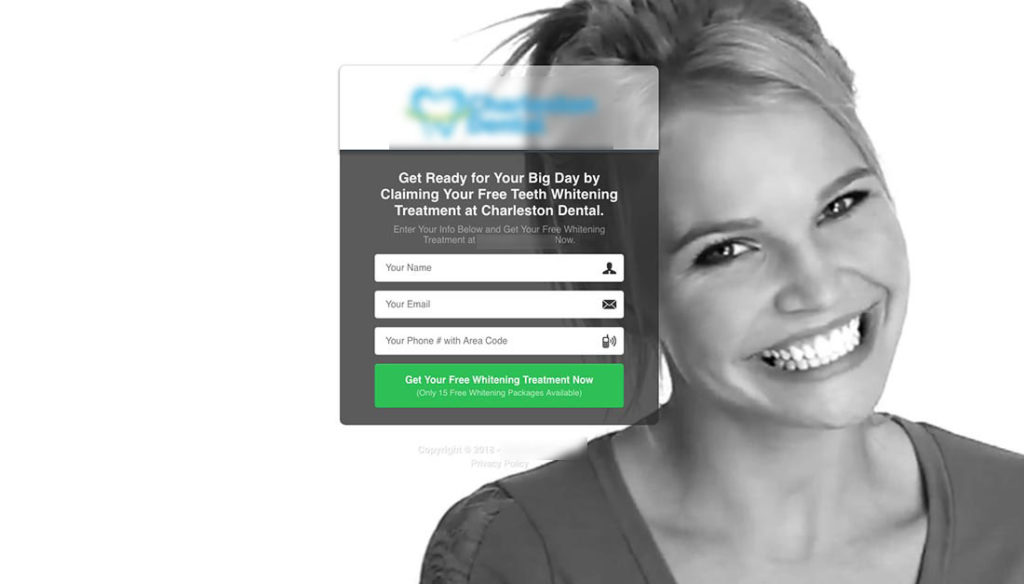
The secret to campaigns that really work is to get people off of Facebook to present the offer.
A “Landing Page” is a special webpage that we create for our clients that allows us to present the offer and get their information without having all of the distractions of Facebook hurting our conversion.
#3: A Thank you, Page, to Push them to Action.
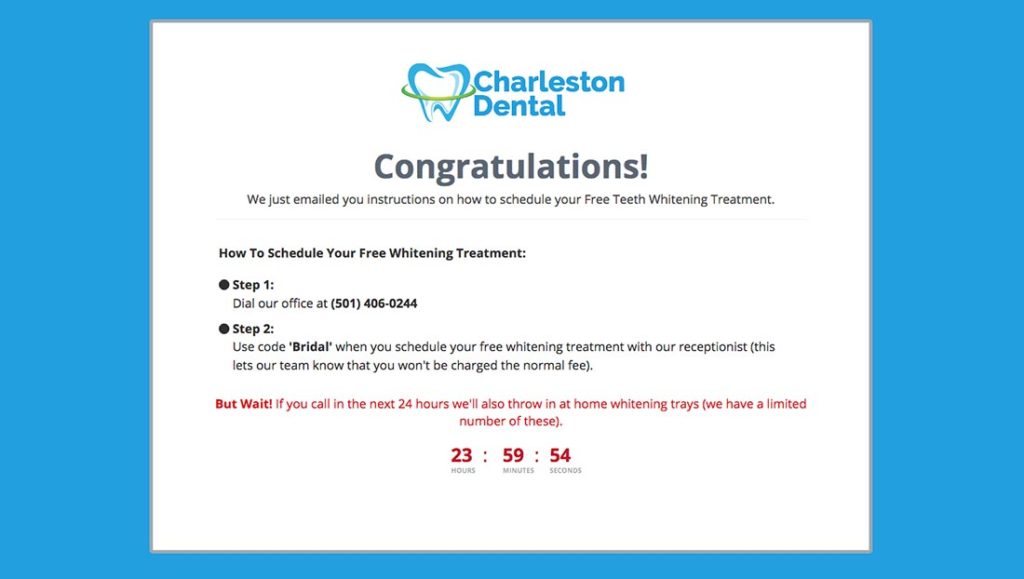
Once someone decides that they want the offer we put in front of them, and puts their information in on the “landing page”, we want to send them to a special page that “accelerates” their conversion into a real customer.
To help get people to take action faster, we build a special webpage called a “thank you page” with an inbuilt scarcity that pushes them to actually pick up the phone or come into your business right away.
#4: An Eye-Catching Facebook Ad Creative.
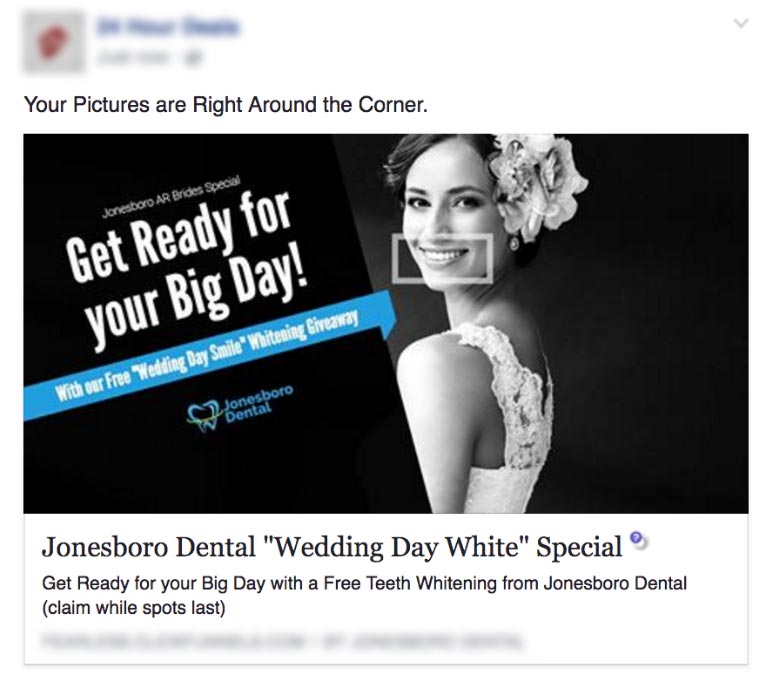
Once you create a great offer and create the pages that you can use to collect leads, you need a great way to put that in front of people.
A Great Facebook ad is “eye-catching” and is also pointed at a very specific audience in your community.
Now, in a similar fashion, we can drive traffic utilizing AdWords. The key difference is that AdWords is search-driven. We place your offer in front of the people who are SPECIFICALLY looking for your solution. The rest is very similar – great offer, great landing page, ‘push-off-the-fence’ thank you page.
CHAPTER 8: WHAT IS A MESSENGER BOT (AND WHY YOU NEED ONE)

Messenger Bots are a relatively new technique in the Digital Marketing world, but one that we’ve had a ton of success with when implementing them for our clients.
A Messenger Bot is a way to leverage the fact that almost everyone out there answers their Facebook Messages right away. We can build very specific campaigns that act like a “Facebook Ad Campaign” (as discussed in the previous chapter) but adds in a very personalized follow-up that happens right inside of Facebook Messenger.
What makes these so effective is that the potential customer feels like they are getting instant attention from your business when they start “talking” to your messenger bot.
Let’s walk through an example of a messenger bot campaign.
An Example of an Effective Messenger Bot Campaign:
Step 1: Post a Great Offer on Your Page.
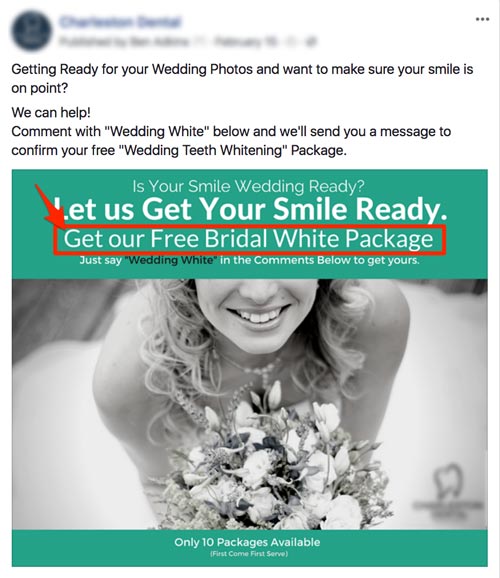
We start off with a simple Facebook post that advertises a great offer. This post looks just like any other Facebook post on your page. The magic happens because we’ve connected a “bot” to listen for responses on the post and to “talk back” to people who comment.
Note: We also use a highly targeted Facebook ad to get our post more attention from the surrounding market.
Step 2: Ask people to Comment to Get the Offer.
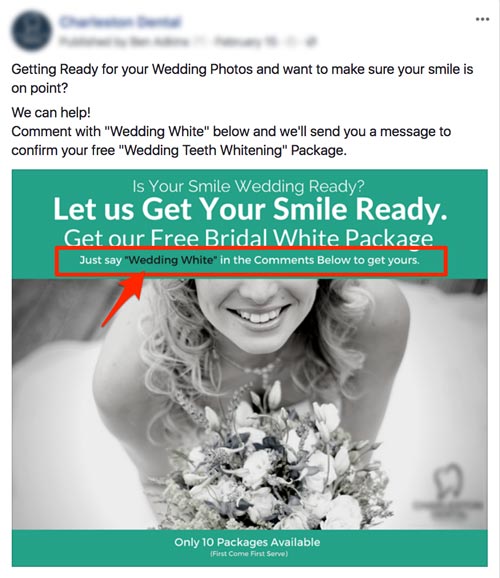
In the post that we created, we ask people to comment if they want to take advantage of the offer.
Step 3: The “Messenger Bot” Replies like a Human would.
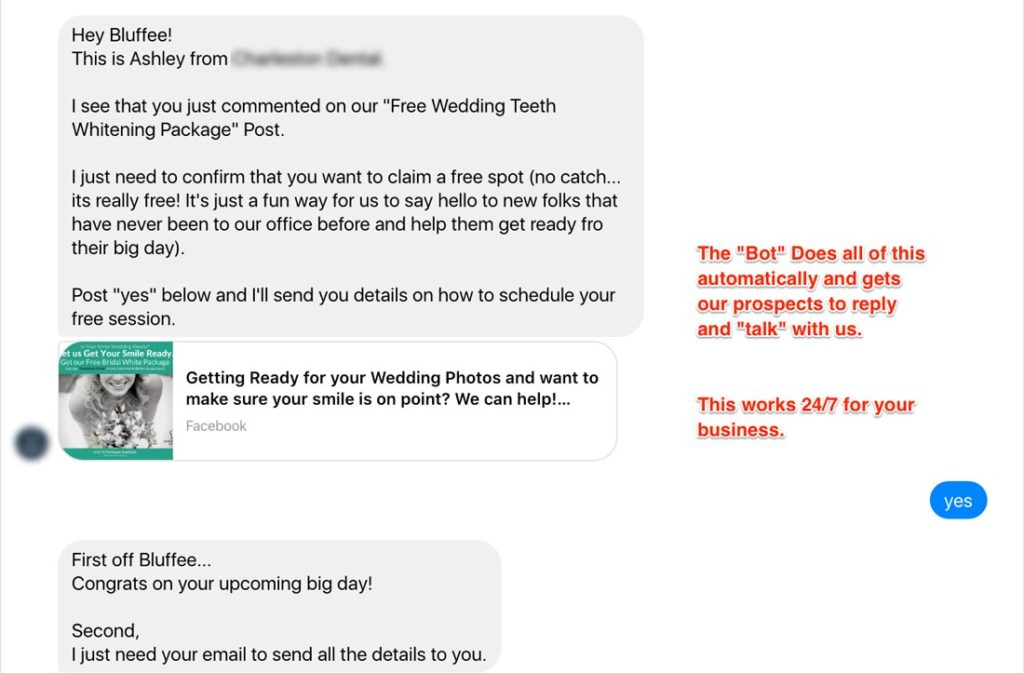
Our messenger bot will wait until someone comments on the post and then it springs into action.
Step 4: The “Messenger Bot” asks for More info.
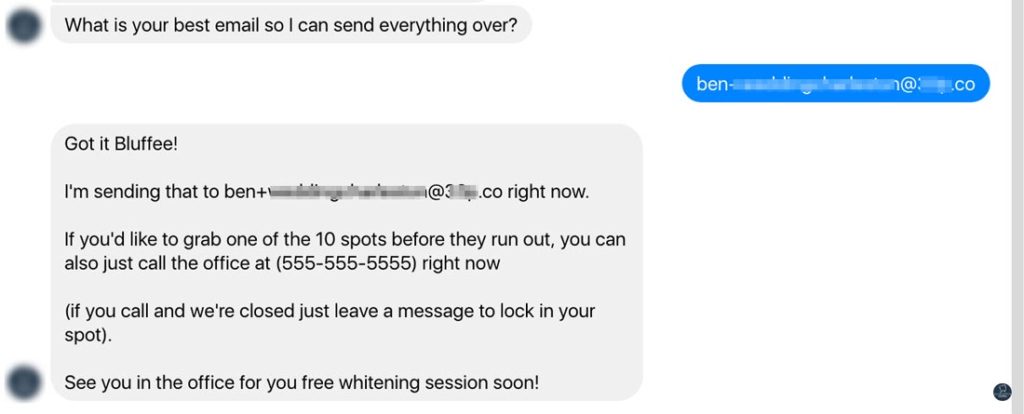
After a little warmup conversation, our messenger bot asks for an email address or phone number so that we can connect with the prospect outside of Facebook.
Step 5: The Business connects with the Lead via Email and Leads to a Phone Call or Visit.

We build an email autoresponder that follows up with the potential client and gets them to call or come in to claim the offer during business hours.
CHAPTER 9: HOW TO SHOW UP IN GOOGLE AHEAD OF YOUR COMPETITORS (SEO)
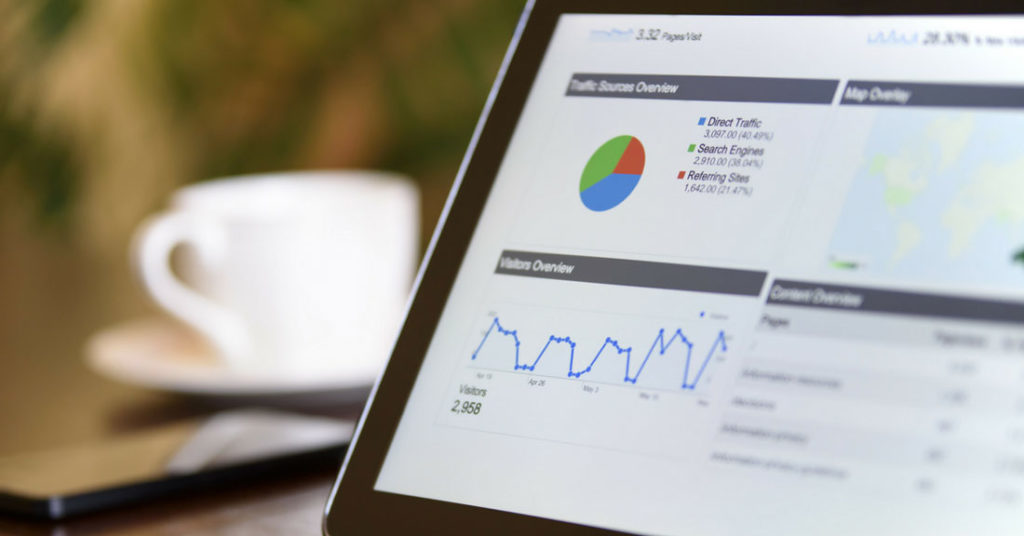
One of the most powerful ways to dominate your market is to make sure that your website shows up first when potential customers search for certain keywords in your market.
While the way Google works may seem random at times, your ranking for certain keywords is actually based on a formula that you can use to your advantage. This is called “Search Engine Optimization” or “SEO” for short.
Word of caution: don’t focus on SEO before you’ve got the other things sorted out first! It doesn’t matter how many people find your website if they don’t engage with you and inquire about your offerings.
Ranking higher on Google for certain search terms is something that most people think is very complicated. With a little patience and some basic knowledge of how it all works, however, it’s a lot easier to rank in your local market than you might think.
There are literally hundreds of things you could do when it comes to Search Engine Optimization. When we’re working with our Local Clients and we launch an “SEO Campaign”, we tend to focus on a few key elements that we’ve found make the greatest impact.
It all starts with making sure we rank for the right keywords and expands out from there.
Let’s cover the core things that we do when we work to Rank Our Clients Higher on Google.
What Brick and Mortar Businesses Need to do to Rank #1 on Google
#1: Figure out the Keywords that Make you Money.
Not all keywords are created equal. One of the core things that you need to figure out before you start optimizing your website is what keywords that you want to rank for.
#2: Make Sure Your Website is Search Engine Friendly.
Once you’ve established a set of keywords that you’d like to rank for, it’s important that you optimize your website to reflect that. Making sure that your site makes use of those key phrases (without overdoing it) is a small, but important, part of actually ranking for those keywords.
This is something that most of our clients have no interest in doing themselves due to the tedious and unpredictable nature of the work involved.
#3: Make Sure Your Website is Mobile Ready.
One of the keys to being “Google friendly” is to make sure that your site is mobile friendly. This means that your website looks equally good on a phone’s screen as it does on a computer’s screen.
Your site being “mobile friendly” or not can drastically affect where your site ranks in the search results.
#4: Regularly Create Keyword-Focused Content that is Interesting.
One of the most important ways that we help our clients rank for certain key terms is through the use of regular new content on their site.
The key to doing this correctly to write content that is interesting to your core clientele but also plays well with the Google’s Search algorithms.
This is something that is often overlooked by traditional SEO firms, but it is vitally important as Google’s algorithms have evolved.
#5: Get Strategic Links from Others.
One of the core elements to ranking higher in a local market is to have a strategic strategy of getting the right websites to link back to your site.
Often this involves getting other important local websites to link to you using the keywords you wish to rank for. This sends a signal to Google that your site is a local authority on a topic and results in higher rankings for that term.
#6: Leverage Your Facebook Page to Spread Your Content.
If you’ve laid a good foundation for your site and Facebook page, it’s important to link the two up.
Google is always looking to see “social signals” that are related to a topic. Getting your latest blog posts to show up on Facebook can be a big boost as it can start the process of getting your content shared by other people.
We focus a great deal of effort on making sure our clients have great content and that it is something that is “share-worthy” on Social Media. This ultimately helps in our effort to rank our client’s websites high in the search results for our desired key terms.
#7 Other more complicated and more time-consuming techniques
Steps mentioned above are enough only if you’re competing against a relatively low level of competition. It would take forever to lay out all the “advanced” stuff
CHAPTER 10: GETTING YOUR CLIENTS TO COME BACK AGAIN AND SPEND MORE MONEY WITH YOU

I will admit – I love Malaysia where I’ve been blessed to live with my family since 2010. I love the people, the weather and so much more…
However, one thing hurts me a lot is seeing how many businesses neglect one of the potentially greatest sources of their income – return customers.
Majority of the otherwise great businesses in this beautiful country expect customers to come back when/if they want and do not take any proactive measures to make sure the customers do not slip away to the competition.
It’s not that difficult to fix. And there are great financial rewards for those who do.
In the past, I have seen companies as much as double their profits just by implementing this one tactic.
What you need is some sort of a way to track your customer purchases, purchase amounts, purchase frequency (get as specific as possible without over-complicating the process and keep it as automated and manageable as possible) + a system to communicate with them (e-mail, phone call, SMS, push notifications, Messenger Bots…) + a system to incentivize them to return and buy more.
Sounds complicated? Well, it may or may not be… however, I won’t deny it – as much as things can be automated, it will still require some effort on your side.
I don’t mean to freak you out… but here’s a cold hard truth: if your competition will start putting these advanced strategies in place before you – most probably your business will suffer. So, read on…
In the chapter about Follow-Up Systems (you can find it here), I already emphasized the importance of keeping at-the-top-of-the-head of your clients and prospects, providing them with valuable insights and reminding about your ‘knock-the-socks-off-awesome’ offers. Now, general, basic follow-up system (Newsletter) is relatively easy to implement and it works to a certain degree.
The issue with it is that we are assuming that all customers are created equal. Well – they are not.
For example, our goal with new customers is to get them to return at least one or two more times. Statistically, clients who have favoured your business 3 times are very likely to become regulars. So, we want to incentivize this behaviour.
Talking about regulars… we want to monitor and preferably automatically run ‘lost customer recovery’ campaigns. Here’s how it works. We set the pre-defined interval during which the customer has not purchased from you and is considered ‘lost’ (e.g. 6 months without any purchases). Once it is triggered, we send a ‘recovery message’ to the customer with the ‘come-back-we-miss-you-offer’.
I’m sure by now you see how all this leads to more sales and more profits for you.
When it comes to the technical side, there are many ways to do it (from the simple Excel sheet tracking to sophisticated automated software apps like our Business Boostly™) and I won’t be able to cover all the possible options here.
Here’s what you should be looking for:
- A simple way to enter, track and monitor purchase history
- Communication Engine. As automated, targeted and relevant as possible.
- Optional: Loyalty Rewards system (Reward Points that can be redeemed for discounts or free products/services). Optional since it may not be applicable to your specific business (e.g. your clients, in general, tend to stay with you in a long-term so loyalty is not an issue).
CHAPTER 11: ORCHESTRATE REFERRALS FROM EXISTING CUSTOMERS AND PARTNERSHIPS

Referrals should be one of the top marketing strategies you should focus on.
Why? Because referrals are likelier to translate into more clients than leads generated through other marketing methods.
If word-of-mouth is already generating a large portion of your business – congratulations… don’t rush to skip this chapter yet, though.
The key word in the title of this chapter is ‘orchestrate’. It means, to have a systematic way of generating new leads through the word of mouth and through collaboration with the partners. We’re talking manual or automated systems here.
Depending on your business model, there are different types of referral strategies that will be more suitable for you. I won’t be able to cover them all here but here’s something to trigger your mind.
In almost any successful customer journey, there’s at least one “moment of delight,” a point at which the customer is happiest with or most excited about your product, service, or brand. These “moments of delight” are perfect opportunities to present customers with the opportunity to refer others to your product or service.
The simplest way is to just ask for an introduction at that very moment. Do it tactfully but systematically and you’ll get referred.
Although you may or may not incentivize it, always remember to thank the person who referred to you even if it didn’t turn into the sale.
From the technological standpoint, nowadays it is possible to track and credit users in the multitude of ways. Example:
- A customer shares your great, viral, educational post (somewhere along the line there’s a Call to Action) on social media. Friends visit the post and respond to with the desired action (book, buy, order, call, submit a form). The customer who referred can get credit in the form of a discount coupon, free product, cash etc.
- A customer shares coupon and receives a coupon in exchange (companies like Grab are successfully utilizing this strategy).
- Affiliate link tracking. Think about the organizations that are not directly competing with you but are serving the same customers. Call it Joint Ventures, Affiliate Relationships or Strategic Partnerships, it doesn’t really matter. What matters is that they can use their special coded tracking URL to send loads of visitors to your website or landing page. Once the visitor takes your desired action – you can reward them. Everyone wins.
There are more ways but this should provide enough ideas to get you thinking… executing… and generating tons of more business.
CHAPTER 12: HOW TO GET SOMEONE TO DO EVERYTHING FOR YOUR BUSINESS
I realize the number of folks that you have contacting you every week who want to provide digital marketing services for you. I also realize that it’s hard to know if they can ACTUALLY help you and even if they know what they are doing.
I hope that this guide has given you a good foundation so that you understand what is available and what should be done in what order. We’re building Virtual Mavericks so that we could help Brick and Mortar Business owners keep up with the quickly changing Digital Marketing Landscape and to always get them positive Return on the Investment.
If you have any questions at all about how to implement any of the above in your business, feel free to contact me and just ask.
No matter who you decide to use to help you build your business, I hope this guide has been a powerful jumpstart and got you going on the right path and helps you make an informed decision when you finally do choose a provider.
Thanks so much for reading!
